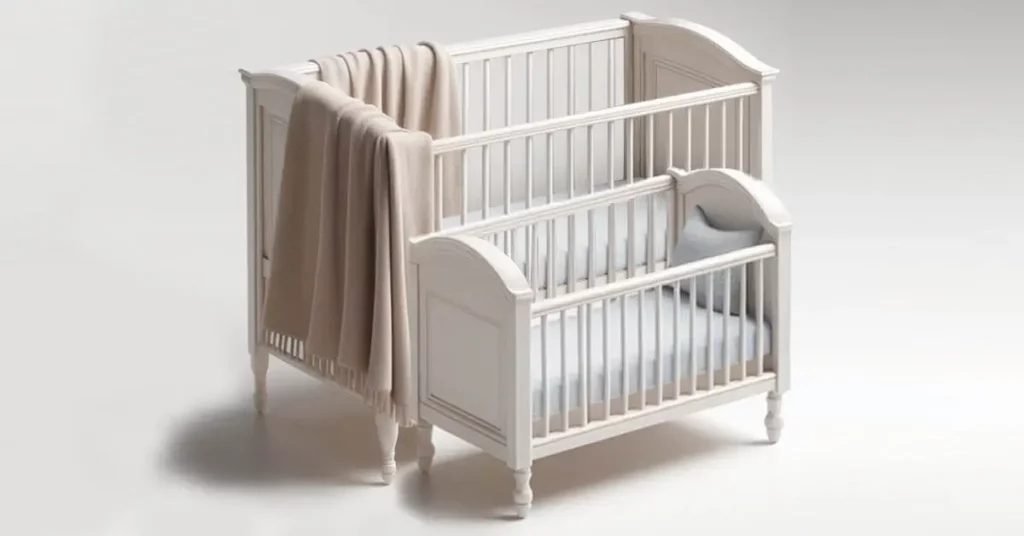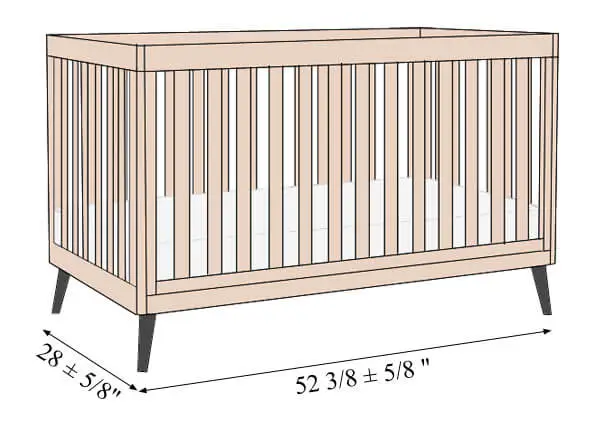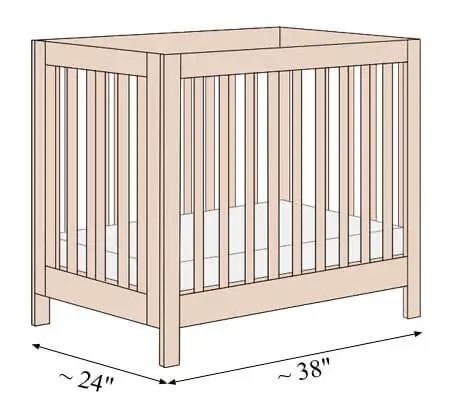
When choosing a crib, you need to consider several factors, and size should be at the top of your list. This guide will explain crib dimensions, focusing on mini crib vs standard crib size. Each has unique features and size to cater to different needs and rooms. Knowing their differences will help you choose the best crib for your available space.
Crib dimensions, mini and standard, fall into two main categories: interior and exterior. Interior dimensions refer to the inside measurements of the crib where your baby sleeps. Knowing these is crucial for buying the right-sized crib mattress.
Exterior dimensions include the crib’s overall size. This includes the frame and any extra features like storage drawers or changing tables. Since cribs have different frames, their overall size can vary a lot. You need to know the overall crib’s dimensions to ensure your crib fits into your space.
Standard Crib Size
A standard crib provides ample space for your baby to sleep and grow comfortably. It is the most common type of crib found in nurseries.
If you have enough room, we recommend a standard crib size. First, it lasts longer. Second, if you choose a convertible option, it can be the only bed you will ever need for your child. Third, standard cribs tend to be sturdier than mini options. Fourth, you have a wider selection of standard-size crib mattresses to choose from.
The internal dimensions of standard cribs are set by law, especially in countries like the United States, Canada, and those in the European Union. Their regulations ensure safety and compatibility with crib mattresses and bedding. As a result, all standard-size crib mattresses fit into any standard-sized crib without dangerous gaps.
In the United States, standard cribs’ dimensions are controlled by the Consumer Product Safety Commission (CPSC). The CPSC states that the inside of the crib must be 28 ± 5/8 inches (71 ± 1.6 cm) wide and 52 3/8 ± 5/8 inches (133 ± 1.6 cm) long.

The external dimensions depend on the crib’s design and added features like decorative elements or storage. They generally range around 54 inches in length and 30 inches in width.
Pros and Cons of Standard Crib Size:
PROS
- Standard cribs can be used from infancy until your child transitions to a toddler bed, often around 3-4 years old.
- Their larger size offers more stability, making them less likely to tip over.
- Provides a spacious sleeping area for your baby.
CONS
- Standard cribs require more space, which might not be ideal for smaller nurseries or apartments.
- They are bulkier and more challenging to move or store when not in use.
A Standard Crib is Best For:
- Parents with plenty of space.
- Those who want to use the crib through various stages of their child’s early years.
- Parents with multiple children. They are strong enough to be used by younger siblings.
Mini Crib Size
Mini cribs are an ideal choice for smaller spaces. They are perfect for small apartments, urban lofts, grandparents’ homes, or parents needing a secondary crib.
The government does not regulate the interior dimensions of mini cribs, so their sizes can vary. Any crib smaller than the standard crib size is thus classified as a mini crib.
Despite the lack of specific dimension regulations, mini cribs are a safe option. They must meet strict safety standards for slat spacing, mattress fit, and structural integrity.
The only downside of the “lack” of mini crib size regulation is that not all mini mattresses fit into all mini cribs. Thus, most mini cribs come with a mattress that fits snugly without gaps. However, that is more of a mattress pad, and we usually recommend buying a better mattress.
It is good to know that most mini crib manufacturers follow an unwritten standard for mini crib sizes. Typically, mini cribs have interior dimensions of about 38 inches in length and 24 inches in width. This significantly eases the search for a proper mini mattress.

Exterior dimensions of mini cribs generally range around 40 inches in length and 26 inches in width, making them easier to fit in tight spaces.
Pros and Cons of Mini Crib Size:
PROS
- Perfect for small nurseries, grandparents’ homes, apartments, or secondary sleeping areas.
- Easy to move around the house and store when not in use.
- Often more budget-friendly than standard cribs.
CONS
- Typically used for a shorter period as children outgrow them faster.
- Fewer choices for mattresses and bedding compared to standard cribs.
A Mini Crib is Best For:
- Small nurseries or apartments with restricted space.
- Grandparents as they can move the crib away.
- Parents who need to move the crib around their home.
- For a second room, like the parents’ bedroom, for easy nighttime access.
Why is Crib Size Important?
Choosing the right crib size is crucial for both safety and practicality. Here’s why:
- Safety: A crib that fits well in your space reduces the risk of accidents. Crowded rooms can be hazardous.
- Comfort: Your baby needs enough room to move and sleep comfortably without rolling into unsafe positions.
- Space Management: A well-fitting crib helps keep your nursery organized and makes the best use of space.
Comparison Chart: Mini Crib vs Standard Crib Size
To help you visualize the differences, here’s a comparison chart highlighting the key features of mini cribs and standard cribs:
| Feature | Mini Crib | Standard Crib |
|---|---|---|
| Interior Dimensions | 38″ L x 24″ W | 52″ L x 28″ W |
| Exterior Dimensions | 40″ L x 26″ W | 54″ L x 30″ W |
| Longevity | Suitable for infants to around 1-2 years | Suitable for infants to around 3-4 years |
| Portability | High | Low |
| Space Requirements | Minimal | Requires more space |
| Cost | Generally less expensive | Generally more expensive |
| Best For | Small spaces, secondary cribs, travel | Larger nurseries, long-term use, multiple children |
Conclusion
Choosing between a mini crib and a standard crib depends on your needs and the space in your nursery. Standard cribs are durable and can last for many years. They are a great choice for larger nurseries and families who plan to use the crib for multiple children.
Mini cribs are perfect for smaller spaces. They are compact, portable, and easy to move or store.
But the most important thing is that the crib meets all safety standards and provides a safe and cozy sleeping space for your baby!
For more tips on choosing the best baby crib, look around our site, BabyCribHub.com. We are your trusted resource for baby cribs and nursery essentials.
